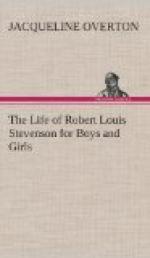“Since the fifth day,” he wrote, “we were left behind by a full-rigged English ship ... bound round the Horn, we have not spied a sail, nor a land bird, nor a shred of sea-weed. In impudent isolation, the toy schooner has plowed her path of snow across the empty deep, far from all track of commerce, far from any hand of help; now to the sound of slatting sails and stamping sheet blocks, staggering in the turmoil of that business falsely called a calm, now, in the assault of squalls burying her lee-rail in the sea.... Flying fish, a skimming silver rain on the blue sea; a turtle fast asleep in the early morning sunshine; the Southern Cross hung thwart the forerigging like the frame of a wrecked kite—the pole star and the familiar plough dropping ever lower in the wake; these build up thus far the history of our voyage. It is singular to come so far and see so infinitely little.”
The squalls that came very quickly, frequently broke the monotony of the trip. One moment the Casco would be sailing along easily and the “next moment, the inhabitants of the cabin were piled one upon another, the sea was pouring into the cockpit and spouting in fountains through forgotten deadlights, and the steersman stood spinning the wheel for his life in a halo of tropical rain.”
After twenty-two days at sea they sighted their first island, Nukahiva, one of the Marquesan group, and were all on deck before dawn anxiously watching for it. They not only looked forward eagerly to the sight of land again after so many days on the open ocean, but it was indeed an adventure to come to a country totally strange to all of them, where few white people had been before.
“Not one soul aboard the Casco had set foot upon the Islands,” says Stevenson, “or knew except by accident one word of any of the island tongues; and it was with something perhaps of the same anxious pleasure as thrilled the bosom of the discoverers that we drew near these problematic shores.
“Before yet the anchor plunged a canoe was already paddling from the hamlet. It contained two men: one white, one brown and tattooed across the face with bands of blue, both immaculate with white European clothes.... Canoe followed canoe till the ship swarmed with stalwart, six foot men in every stage of undress ... the more considerable tattooed from head to foot in awful patterns ... all talking and we could not understand one word; all trying to trade with us who had no thought of trading, or offering us island curios at prices palpably absurd.”
All this charmed and delighted Stevenson, who had dreamed many times of witnessing just such a scene. He wrote to Cummie that he was living all over again many of the stories she had read to him and found them coming true about himself.
For six weeks they cruised about among these islands, frequently dropping anchor and going ashore for several days. When the natives were convinced that they had neither come to trade or to make trouble, but were simply interested in them and their country, they made the visitors most welcome and showered presents of fruit, mats, baskets, and fans upon them.




